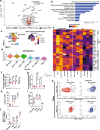Neuronal CaMKK2 promotes immunosuppression and checkpoint blockade resistance in glioblastoma
- PMID: 36309495
- PMCID: PMC9617949
- DOI: 10.1038/s41467-022-34175-y
Neuronal CaMKK2 promotes immunosuppression and checkpoint blockade resistance in glioblastoma
Abstract
Glioblastoma (GBM) is notorious for its immunosuppressive tumor microenvironment (TME) and is refractory to immune checkpoint blockade (ICB). Here, we identify calmodulin-dependent kinase kinase 2 (CaMKK2) as a driver of ICB resistance. CaMKK2 is highly expressed in pro-tumor cells and is associated with worsened survival in patients with GBM. Host CaMKK2, specifically, reduces survival and promotes ICB resistance. Multimodal profiling of the TME reveals that CaMKK2 is associated with several ICB resistance-associated immune phenotypes. CaMKK2 promotes exhaustion in CD8+ T cells and reduces the expansion of effector CD4+ T cells, additionally limiting their tumor penetrance. CaMKK2 also maintains myeloid cells in a disease-associated microglia-like phenotype. Lastly, neuronal CaMKK2 is required for maintaining the ICB resistance-associated myeloid phenotype, is deleterious to survival, and promotes ICB resistance. Our findings reveal CaMKK2 as a contributor to ICB resistance and identify neurons as a driver of immunotherapeutic resistance in GBM.
© 2022. The Author(s).
Conflict of interest statement
P.E.F. reports consulting for Monteris Medical. J.H.S. has an equity interest in Istari Oncology, which has licensed intellectual property from Duke related to the use of poliovirus and D2C7 in the treatment of glioblastoma. J.H.S. is an inventor on patents related to the PEP-CMV DC vaccine with tetanus (US 9974848), as well as poliovirus vaccine (US 11406677) in the treatment of glioblastoma. J.H.S. has an equity interest in Annias Immunotherapeutics, which has licensed intellectual property from Duke University Medical Center related to the use of the pepCMV vaccine in the treatment of glioblastoma. M.K. reports receiving institutional research funding from AbbVie, Bristol Myers Squibb, Celldex and Specialized Therapeutics. M.K. additionally reports consulting/advisory roles with Voyager Therapeutics, AbbVie, Bristol Myers Squibb, Janssen and Janssen, Eli Lilly, Ipsen, Pfizer, and Roche. L.R. and D.P.M. have applied for a patent covering the use of CaMKK2. The remaining authors declare no other competing interests.
Figures








Similar articles
-
CaMKK2 as a therapeutic target to combat metastasis in glioblastoma.Mol Biol Rep. 2025 Jul 10;52(1):696. doi: 10.1007/s11033-025-10813-8. Mol Biol Rep. 2025. PMID: 40637941 Review.
-
CaMKK2 in myeloid cells is a key regulator of the immune-suppressive microenvironment in breast cancer.Nat Commun. 2019 Jun 4;10(1):2450. doi: 10.1038/s41467-019-10424-5. Nat Commun. 2019. PMID: 31164648 Free PMC article.
-
Calcium/Calmodulin Dependent Protein Kinase Kinase 2 Regulates the Expansion of Tumor-Induced Myeloid-Derived Suppressor Cells.Front Immunol. 2021 Oct 12;12:754083. doi: 10.3389/fimmu.2021.754083. eCollection 2021. Front Immunol. 2021. PMID: 34712241 Free PMC article.
-
MiR-1271 regulates glioblastoma cell proliferation and invasion by directly targeting the CAMKK2 gene.Neurosci Lett. 2020 Oct 15;737:135289. doi: 10.1016/j.neulet.2020.135289. Epub 2020 Aug 11. Neurosci Lett. 2020. PMID: 32791096
-
The Current Landscape of Immune Checkpoint Blockade in Glioblastoma.Neurosurg Clin N Am. 2021 Apr;32(2):235-248. doi: 10.1016/j.nec.2020.12.003. Neurosurg Clin N Am. 2021. PMID: 33781505 Review.
Cited by
-
Caspase-4 in glioma indicates deterioration and unfavorable prognosis by affecting tumor cell proliferation and immune cell recruitment.Sci Rep. 2024 Jul 29;14(1):17443. doi: 10.1038/s41598-024-65018-z. Sci Rep. 2024. PMID: 39075190 Free PMC article.
-
Necroptosis-based glioblastoma prognostic subtypes: implications for TME remodeling and therapy response.Ann Med. 2024 Dec;56(1):2405079. doi: 10.1080/07853890.2024.2405079. Epub 2024 Oct 10. Ann Med. 2024. PMID: 39387496 Free PMC article.
-
CaMKK2 Regulates Macrophage Polarization Induced by Matrix Stiffness: Implications for Shaping the Immune Response in Stiffened Tissues.Adv Sci (Weinh). 2025 Apr;12(16):e2417778. doi: 10.1002/advs.202417778. Epub 2025 Mar 4. Adv Sci (Weinh). 2025. PMID: 40036145 Free PMC article.
-
γδ T cells as a potential therapeutic agent for glioblastoma.Front Immunol. 2023 Oct 20;14:1273986. doi: 10.3389/fimmu.2023.1273986. eCollection 2023. Front Immunol. 2023. PMID: 37928546 Free PMC article. Review.
-
Targeting the dendritic cell-T cell axis to develop effective immunotherapies for glioblastoma.Front Immunol. 2023 Oct 20;14:1261257. doi: 10.3389/fimmu.2023.1261257. eCollection 2023. Front Immunol. 2023. PMID: 37928547 Free PMC article. Review.
References
Publication types
MeSH terms
Substances
Grants and funding
LinkOut - more resources
Full Text Sources
Molecular Biology Databases
Research Materials

